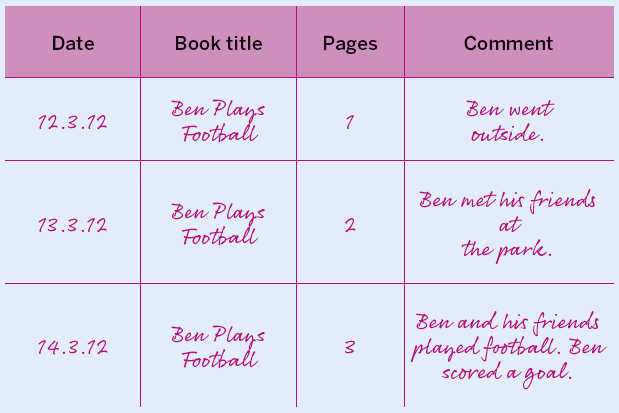Ditch your reading records

They’re a pain for everyone, so let’s do something more useful instead, says Samantha Pope…

- by Sam Pope

When my daughter Amy was at primary school, I used to dread the appearance of a reading record.
At their worst, they were small notebooks with a single narrow column on the left to record the date and a wider column on the right to write down the book title and page number(s) that we had read together.
When the school staff added to this, what resulted was a boring list that read something like this:

One year, I remember the new reading record having an exciting jungle scene on the cover. I thought that this would herald a new year of imaginative recording. It didn’t. It just had wider pages, wider margins and more lines. Did the teacher think that this would make writing a meaningless list of dates and numbers more interesting?
At the end of the day, these lists are meaningless. I know you want to check that your children are reading regularly but this kind of activity is no better than ticking a checklist.
It doesn’t show what the child gained from their reading – how Amy laughed at Ben’s characterisation because he actually hated football and just played to try to be popular, for instance.
We encourage children to read for pleasure because it helps develop them into skilful writers, yet we don’t develop a conversation with them about their reading. If we can’t be bothered to do more than berate them for not logging a date and comment then why should they be bothered about writing in their diaries?
I’ve seen the situation countless times in schools since. I’ve seen staff approach checking the records with tedium and frustration when the children have either forgotten their diaries or not written in them.
Those who have get a tick, a ‘well done’ and perhaps a sticker. For writing page numbers and dates. How is that increasing their vocabulary? How is that developing them as readers?
Eventually, everyone becomes so disheartened by them that they are conveniently forgotten, rendering the entire exercise futile. The sad thing is – it needn’t be!
Be creative
Here’s a novel idea – if you pardon the pun. Why not remove the dreaded ‘record’ from the equation and replace it with ‘journal’? Or ‘diary’? Something that refers to these notebooks as something that can be creative, fun, imaginative – that pupils will want to write in and staff will want to read?
Instead of investing in official reading records with fancy covers, use a simple, lined exercise book and ask pupils to personalise it themselves. In my experience, this act of freedom engages most children and that will get them on side from the start.
Next, explain that while you still want them to date each entry, you really want to know more about their reading choices. Encourage them to be creative. You could give them a list of ideas like this that would be suitable for a reading diary:
- Write a blurb about what your book is about. Sell it to me – make me want to read it!
- Draw a picture of a character and tell me about them.
- Have you found any difficult or interesting words? Write them down and tell me what they mean. Try putting them into sentences of your own.
- Write a short summary of what’s happened in the book so far. What should I know?
- What’s good about the book you’re reading? What don’t you like so much?
- If you were the author, how would you change the story?
- When you’ve finished, write a review of the book. Tell me your honest opinion!
You might want to try this out in class first, giving the children the same activity so you can help them get the hang of using the book.
If you want to be a little more prescriptive in your approach, set specific tasks each week, similar to the ones above. This might work better with some of your children who worry if things are left too much to personal choice.
Reward good work
When you collect the diaries, read through them and turn the work into an ongoing conversation. If a child has written about a character or expressed a view about a storyline, write back to them. Make observations and show interest. Remember: if you can’t be bothered to do this, then why should they?
Here’s an example based on a lovely book I’ve just read called The Secret of Nightingale Wood by Lucy Strange (a fantastic novel for Y5 and 6, if you’re looking for one). I’ll play the part of the pupil and the teacher…
14th February 2020 Today I started reading The Secret of Nightingale Wood. The main character is called Hen and she has moved with her Mother, Father, Piglet – she’s the babysister – and Nanny to a big house in the countryside called Hope House. She sees smoke coming from the woods and thinks there might be something secret there.
Teacher’s comment This sounds intriguing! Do you like Hen as a character? What’s she like? Is Hen a nickname for a longer name? What do you think is the mystery behind the smoke? I can’t wait to read more about what happens to her as you read on.
15th February 2020 Hen is short for Henrietta – I think that’s a strange name! She’s an interesting character because she likes to explore and have adventures. Something is wrong with her mother, and a horrible doctor keeps coming to the house called Dr Hardy. Every time he is mentioned there is something disgusting about him, like his breath smells of kippers.
Teacher’s comment Dr Hardy does sound unpleasant. Do you think there is a reason why the author has written horrible things about him? What is the author trying to say? Here’s a challenge – could you draw me a picture of him based on the descriptions?
As you can see, the exchange between the pupil and the teacher has set up a reading ‘relationship’.
The pupil isn’t just a passive reader anymore – they are being encouraged to give their own thoughts on the text. Adding this sort of communication also doesn’t take much extra time than nagging a pupil about forgetting their record or not writing in it.
This approach works well in KS2. For younger pupils, who still aren’t writing more fluently, you could use an adapted version. For example, ask them to say what the book they read is about (with the help of their parents or carers).
They could draw pictures of what happens. I’ve had some fantastic reviews from children in Y2, so they are capable of a more simplified version. Treat a reading record as something special, rather than something boringly ordinary – and you may get something amazing as a result.
Samantha Pope is librarian at St Michael’s CE Primary in Oxford. Find out more at childtasticbooks.com and on Twitter at @childtastic.











